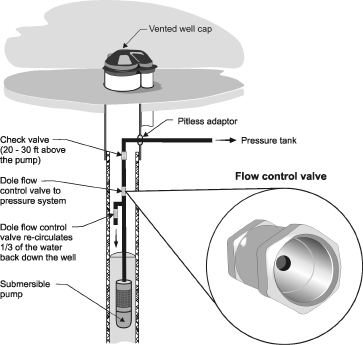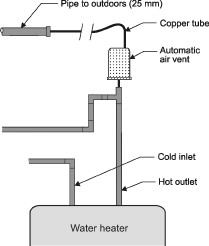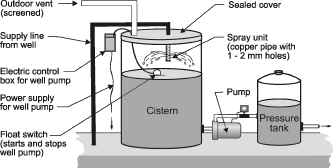| | Air volume controls | Venting the well casing | Pumping problems | Pressure tanks | Controlling gas in water heaters | Aeration and ventilation
Dissolved gases in well water are a common ocurrence in Alberta. The major gases found in wells are methane, carbon dioxide, nitrogen and hydrogen sulfide.
Information on hydrogen sulfide, a gas with a rotten egg odour, is discussed in Agrifacts 716 (D14) Hydrogen Sulfide Removal, so hydrogen sulfide will not be discussed in this publication. Common problems with methane and carbon dioxide are "spurting" taps and priming problems (gas locking) in pumps. The gas problem varies in severity - from occasional "spurting" from the hot water taps to a constant flow of gas from the well casing.
Methane, carbon dioxide and nitrogen are all odourless gases. Exercise caution if the water contains methane. Methane will burn, can be explosive and must be vented to the outside. For further information on Methane Gas in Well Water, refer to Agrifacts 716 (D63). Carbon dioxide and nitrogen should also be vented to the outside because these are asphyxiates and can cause death by suffocation. Carbon dioxide is heavier than air and can accumulate in low, enclosed spaces, such as wells or pump pits. Well pits are no longer legal in Alberta, but many old pits still exist. Accumulated nitrogen in a well pit killed two Alberta teens in 1999.
The ability of water to hold gases varies with temperature and pressure. As water temperature increases, the amount of gas released increases. Gas "spurting" will often be worse from the hot water taps than the cold. Gas will escape from water more readily if left in an open tank than if it is contained in a pressure system or underground in an aquifer.
One method for detecting gases is to fill a glass with water from the tap. The water may appear milky-looking, with fine bubbles emanating from the bottom to the top. If the water clears from the bottom to the top as these bubbles rise, dissolved gases are present.
Air Volume Controls
A gas problem should not be confused with an improperly operating air volume control. Some older pressure systems are designed to add air to the pressure tank whenever the pump is operating. This type of system requires a deep well air volume control to release excess air from the pressure tank. If this control is not working, or is not installed, the pressure tank will become overcharged with air. This is a common cause of "spurting" taps.
Venting the Well Casing
If gas is present in the well, vent the casing to prevent gas from accumulating. If a pitless adaptor is used as the well connection, there is normally no ventilation problem because most pitless adaptors have ventilated caps. If the well connection is in a pit, pump house or house basement, the well casing must be vented to the outside. This venting can be done by installing a sanitary well seal with a vent pipe leading to the outside. To solve the problem in a pit, install a pitless adaptor, extend the casing above the ground surface, and backfill the pit where practical.
Pumping Problems
Severe gas problems may cause the gas locking (loss of prime) of submersible and jet pumps. Gas locking can sometimes be remedied by modifying the pump in consultation with representatives of pump companies, water well drillers or an agricultural water specialist.
When groundwater contains significant amounts of methane gas, it sometimes causes gas-locking problems in submersible water pumps. In a typical gas-lock situation, the pump will be operating normally, then quit pumping for no apparent reason, but the pump keeps running. Gas bubbles collect in the impellers of the pump and prevent water from moving through the pump. If the pump is shut off for a while and then re-started, it will usually start pumping water again. In the past, solutions to this problem included:
- drilling holes in the submersible pump impellers to release the air bubbles
- moving the pump check valve from the top of the pump to 5 or 10 feet above the pump
- installing a shroud around the pump to divert gas bubbles past the pump intake
These solutions have had less than a 50 percent success rate. However, a fourth method has proven to work well in many situations. It involves diverting some of the water back down the water well, while the remaining water is pumped to the pressure tank.
Installation
The pumping system is modified so that 1/3 of the water is diverted back down the well and 2/3 is pumped into the pressure tank. For example, assuming that the pump is capable of pumping 6 gpm, then 2 gpm would be diverted back down the well and 4 gpm would be pumped to the pressure tank. Figure 1 shows the installation. Sometimes, the check valve in the pump needs to be removed.
A number of these installations have been done in the Camrose area. Almost all of them proved to be successful. Occasionally, a larger pump had to be installed and sometimes the check valve in the pump had to be removed.

Figure 1. Submersible pump using dole valve bypass
Pressure Tanks
Glass lined or "precharge type" pressure tanks are not suitable for use when water contains dissolved gases since they have no provision for releasing excess gas. Gases will build until they fill the tank, escape into the water lines and spurt from the taps when they are opened.
A standard galvanized pressure tank has the proper outlet for the installation of a deep well air volume control, which will release the excess gas from the tank. If the gas in the water is flammable (i.e. methane), this air volume control must be connected to a copper or plastic tube, which leads outside. Increase the vent tube size to at least 25 mm where it goes through the outside wall to prevent freezing.
Controlling Gas in Water Heaters
Often a gas spurting problem is only present at the hot water taps. Gas can be removed from the water heater using the type of automatic gas vent used for steam and hot water heating installation (see Figure 2). Gas released from the water in the heater collects in the automatic gas vent. When sufficient gas builds up to cause the float in the vent to drop, a valve opens and the gas is released. As the gas is released, water fills the vent and the float rises to close the valve in the vent. This vent will not eliminate the spurting, but it will make the problem much more tolerable.

Figure 2. Gas vent for a water heater

Figure 3. Aeration systems for gas removal
Aeration and Ventilation
If the gas problem is extreme, removing the gas by aeration may be necessary (see Figure 3). The water is pumped to the aeration unit and sprayed into a sealed tank, which is vented to the outside. The water level in the tank can be controlled with a "pump up" float switch. This switch operates the well pump or opens a normally "closed" solenoid valve.
A second pump takes the water from the tank and supplies water under pressure to the distribution system. It is recommended that an aeration system be specially designed for each individual situation.
For more information
Additional information is available through Agricultural Water Specialists or on the Alberta Agriculture and Forestry website.
Agricultural Water Specialists can be contacted through the Alberta Ag-Info Centre at 310-FARM (3276).
Prepared by:
Farm Water Supply Section
Irrigation and Farm water Branch
Alberta Agriculture and Forestry
Source: Agdex FS716(D18). Revised July 2006. |
|